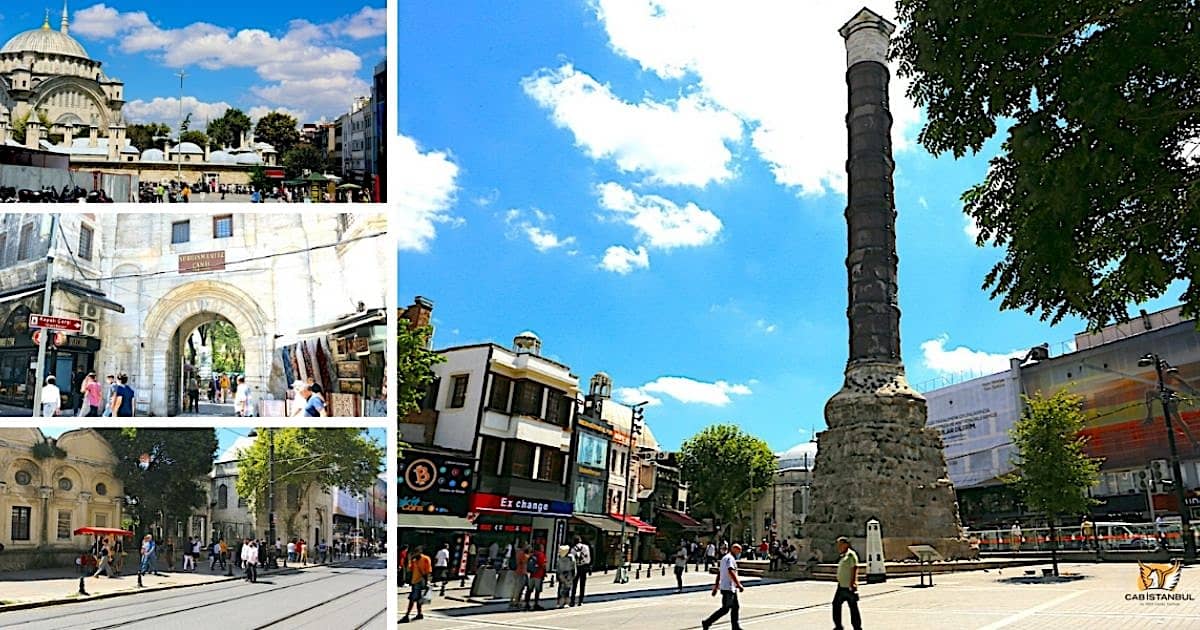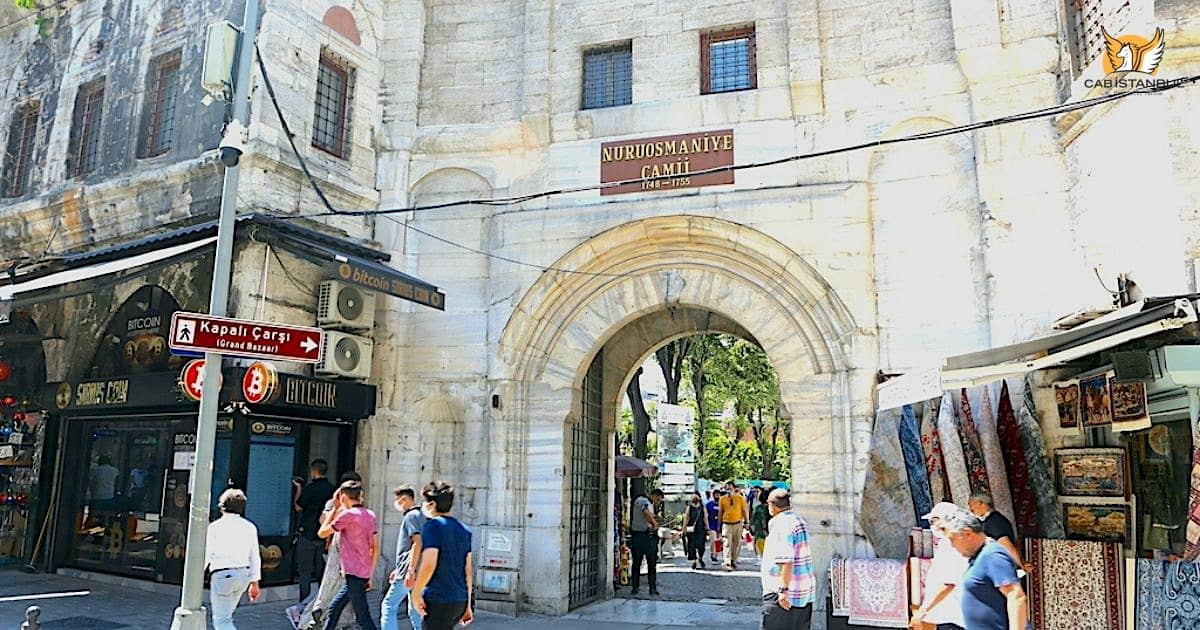Column of Constantine and Nuruosmaniye Mosque İstanbul
2025-12-14

Cemberlitas / Nuruosmaniye Mosque
The Column of Constantine stands majestically in the heart of Istanbul's historic Cemberlitas Square, merely 300 meters from the entrance of the Nur-ul Osmaniye Mosque and adjacent to the main entrance of the Grand Bazaar. This area is a cornerstone of Istanbul's Old City, renowned for its rich history and architectural wonders. Among its most iconic landmarks are the Column of Constantine, Cemberlitas Bath (Hamam), Grand Bazaar, Basilica Cistern, and the serene Mescid El-Nuruosmaniye. Together, they create a cultural and historical mosaic that captivates both locals and tourists alike.
Istanbul's Old City unveils the stories behind these ancient treasures and offers practical advice for navigating Çemberlitaş. This ensures a seamless exploration of both the past and present of Istanbul. Whether you're a history enthusiast, an architecture aficionado, or simply in search of the soul of Istanbul, join us. We promise a captivating journey through the annals of history, exploring the awe-inspiring construction of the Column of Constantine, the stories it harbors, and its integral role in the cultural tapestry of Çemberlitaş. Discover Istanbul's Historical Peninsula Hassle-Free with Our car and driver rental service. While we don't provide chauffeur services or private Istanbul transfers, the tram is the most practical way to explore the area, including Çemberlitaş Bath and Column
Column of Constantine İstanbul
Cemberlitas Square
Cemberlitas Square nestled amidst the bustling streets of Istanbul's Fatih district, between Sultanahmet Square and the Grand Bazaar, stands an awe-inspiring relic of ancient Rome: The Column of Constantine. This remarkable monument, originally towering at a staggering 57 meters (about 35 meters today), has witnessed centuries of history, myths, and transformations, making it a must-visit destination for both local and international tourists. Story of Cemberlitas and its iconic column—a tribute to the Great Constantine, the Roman Emperor who brought it from Rome to Constantinople, the city destined to become the capital of a great empire.
Column of Victory of Constantine
In a bold proclamation of his victory, Constantine ordered the construction of a grand victory column in the heart of his newly established capital. Çemberlitaş took form as nine massive circles, each weighing a staggering 3 tons, were meticulously stacked upon one another. Atop this monumental structure rested a statue of Apollo, a relic from the Temple of Apollo in Rome, brought to its new home in 328 AD. This juxtaposition of pagan imagery might raise eyebrows, but as we delve deeper into Constantine's legend of Jesus, we'll discover a more profound narrative.
The Grandeur of Constantine's Monuments
When Constantinople was inaugurated on May 11, 330 AD, the Constantine Forum, where Çemberlitaş now stands, was a sight to behold. This elliptical expanse featured grandiose Senate buildings crafted from marble, towering and luminous columns, statues, and at its center, a triumphant centerpiece.
Upon the pedestal of the Constantine statue, an inscription read: "O Lord Jesus, lord and ruler of the world, I dedicate this obedient city, this scepter and all the power of Rome to you. Protect Rome, keep all evil away from us."
As the years passed and Christianity ascended to become the empire's official religion, the statue of Apollo was removed, replaced by emperors' statues, starting with Julianus and later Theodosius. In the 11th century, during the time of Manuel Komnenos, a colossal cross replaced the statue, which had been felled by a storm, and there were accounts that even a lightning strike befell Julianus' statue.
The Çemberlitaş Column serves as a tangible chronicle of Constantinople's transformation from a pagan empire to a bastion of Christian faith. Its enduring presence resonates with history enthusiasts and travelers alike, beckoning them to explore its captivating past and timeless allure.
History of Cemberlitas Column
Cemberlitas Hamam / Bath
Cemberlitas Hamam: Where Time-Honored Traditions Flourish. Nestled in the shadow of the Çemberlitaş Column, Çemberlitaş Hamam stands as a testament to architectural splendor and cultural preservation. This splendid bathhouse was commissioned by Sultan II. Selim and Nûrbânu Sultan in 1584, designed by none other than the celebrated architect, Mimar Sinan. The hamam's storied history finds mention in the annals of Evliya Çelebi's travelogue, the Seyahatname.
Across from the bathhouse, the Köprülü Mehmed Pasha Mosque, madrasah, and tomb grace the cityscape. Nearby, you'll discover the Vizier Han, the historic Dar'ülfünun building, the final resting place of Sultan II. Mahmud, the Köprülü Library, Atik Ali Pasha Mosque, madrasah, and Ali Baba Tomb—all within easy reach. A visit to this historical district would be incomplete without indulging in the authentic Turkish bath experience offered by Çemberlitaş Hamam.
Where is Column of Constantine?
In the heart of Istanbul, where the past effortlessly merges with the present, lies Çemberlitaş Square—a place teeming with history and vibrant life. During the Ottoman era, this square thrived as a bustling hub, much like it did in Roman times when it was part of the city's main road, Divanyolu Street. The conquest of Istanbul saw the Constantine Forum, once an iconic Roman landmark, fall into disrepair and obscurity. Yet, amid the tumultuous shifts in the city's landscape, the Çemberlitaş Column remained a steadfast sentinel of the past. Over time, the cross that crowned it naturally descended.
In the 17th century, a destructive fire left the column scarred and weathered. To safeguard this historical treasure, Sultan Mustafa II encircled it with iron rings in 1701. Gradually, the people began to affectionately refer to the monumental column as Çemberlitaş, and the square took on the same name. This moniker has endured through the ages, reminding us of the city's ever-evolving narrative.
Nuruosmaniye Mosque
The Nuruosmaniye Mosque, an architectural marvel, embodies the transition of Ottoman architecture into the realm of baroque aesthetics. Built between 1748 and 1755, this mosque was the brainchild of architects Mustafa Ağa and Simon Kalfa. It stands as a testament to the nascent Western influences seeping into Ottoman design during that period. The mosque complex, comprising a madrasa, almshouse, library, tomb, fountain, and a public fountain, is a hallmark of this architectural transformation. The influence of Baroque art is evident in the library, tomb, fountain, and public fountain, adding a distinctive charm to this remarkable religious edifice.
In Çemberlitaş, the past and present coexist harmoniously, offering visitors a glimpse into Istanbul's rich tapestry of history, culture, and architectural evolution. It is a district where every street, square, and monument tells a compelling story of the city's enduring allure.
Cemberlitas Bath / Hamam
Discover Nuruosmaniye Mosque
Nuruosmaniye Mosque: A Beacon of Ottoman baroque architecture in the heart of Istanbul, Mescid El-Nuruosmaniye stands as a magnificent example of Ottoman Baroque architecture, marking a pivotal moment in the city's architectural evolution. Constructed between 1748 and 1755, this mosque was the first major structure to embrace the Baroque style, symbolizing a new era in Ottoman art and architecture. Its name, translating to "The Light of Osman," not only reflects the mosque's physical luminance but also its historical significance as a source of enlightenment and spiritual guidance.
Nuruosmaniye Mosque isn't just a place of worship; it's a testament to the rich cultural tapestry of Istanbul, offering visitors a chance to explore the exquisite craftsmanship of its domes, arches, and minarets. The mosque's interior, adorned with intricate calligraphy and lavish decorations, captures the essence of its era, providing a serene sanctuary for reflection amidst the hustle and bustle of the city.
Nuruosmaniye Grand Bazaar Gate
Adjacent to the mosque, the Nuruosmaniye Grand Bazaar Gate serves as a grand entrance to one of Istanbul's most iconic landmarks, the Grand Bazaar. This gate is not just a physical doorway but a passage through time, leading visitors into the world's oldest and largest covered market. With its construction closely tied to the mosque, the Nuruosmaniye Gate exemplifies the seamless blend of function and artistry that characterizes Ottoman architecture.
Stepping through the Nuruosmaniye Gate, visitors are transported into a labyrinth of history and commerce, where the vibrant atmosphere of the Grand Bazaar awaits. This gate symbolizes the threshold between the old and new, inviting explorers to discover the endless treasures within—from handcrafted goods and antiques to spices and textiles, each telling its own story of Istanbul's illustrious past and dynamic present.
Nuruosmaniye Mosque

Where is Cemberlitas Column?
How to reach Çemberlitaş, a district brimming with historical treasures, including the iconic Column of Constantine, Çemberlitaş Hamam, and Nuruosmaniye Mosque. Whether you're a history enthusiast or simply looking to soak in the local culture, Çemberlitaş has something to offer for every traveler.
Reaching Çemberlitaş: Transportation Options
1. Tram: A Hassle-Free Journey
One of the easiest and traffic-free ways to reach Çemberlitaş is by taking the tram numbered T1. This tram route winds its way through some of Istanbul's most iconic neighborhoods, making it a delightful journey in itself. Here's the route:
Zeytinburnu: The tram journey begins at Zeytinburnu, where you can immerse yourself in the city's coastal charm.
Eminönü: Next, you'll pass through Eminönü, a bustling area known for its lively atmosphere and historic sites.
Kabataş: Finally, the tram route culminates at Kabataş, offering stunning views of the Bosphorus and easy access to other parts of Istanbul.
2. Bus: Exploring at Your Own Pace
Alternatively, if you prefer to explore Istanbul at your own pace, consider taking a bus to Çemberlitaş. Several bus routes connect various parts of the city to this historic district, providing you with the flexibility to choose the most convenient route for your journey:
- 97 Güneşli – Beyazıt
- 28 Topkapı – Edirnekapı
- 93 T Zeytinburnu – Taksim
- 97 Güneşli – Beyazıt
- 32 A Cevatpaşa – Beyazıt
Each of these bus routes offers a unique perspective on Istanbul's diverse neighborhoods, allowing you to uncover hidden gems and local culture along the way.
Now that you know how to reach Çemberlitaş, you're ready to embark on a journey through Istanbul's historic district. As you explore the streets, squares, and monuments of Çemberlitaş, you'll discover the city's enduring allure and the captivating stories that have shaped its rich history. Whether you choose the tram for a hassle-free commute or opt for a leisurely bus ride, your adventure in Çemberlitaş promises to be an unforgettable experience, where every corner reveals a piece of Istanbul's vibrant heritage
Column of Constantine-Sultanahmet

